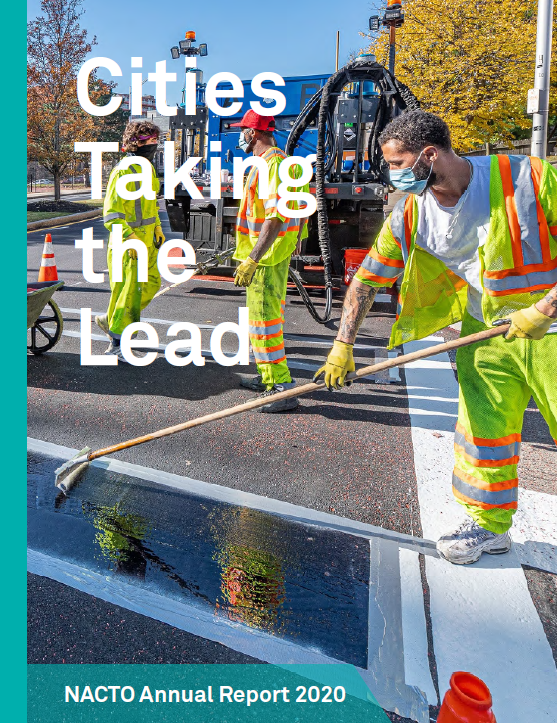This time last year, writing our 2019 annual report, we never would have guessed what the year ahead would hold. 2020 tested us—as individuals, as an organization, and as an industry.

Click to read NACTO’s 2020 Annual Report (pdf)
Over the past year, the COVID-19 pandemic upended lives, livelihoods, and economies, and laid bare existing inequities. The police murders of George Floyd and Breonna Taylor led to wide-scale demonstrations worldwide about the ongoing impact of police brutality and anti-Black racism in society, and deepened our profession’s ongoing reckoning with systemic injustice. And the climate crisis became more widespread and urgent, while transportation remained a primary source of carbon emissions.
Even with these enormous, and still present, challenges, there is cause to recognize what NACTO, our members, and the city transportation field accomplished over 2020. Work from this past year showed that transforming streets is not only possible—but necessary—to support public health and address structural inequalities, a faltering economic recovery, and a changing climate.
These crises are daunting, but the radical optimism infused into NACTO’s work compels us to keep pushing. So, please, join us in looking back on NACTO’s 2020 work, as we reflect on what we’ve achieved and what we still seek to do: support cities as they build streets that put people first.
Over 2020, NACTO supported members responding to the COVID-19 pandemic. We:
- Launched the COVID-19 Transportation Response Center, a clearinghouse of resources to support city and transit agency staff as they responded to immediate needs brought on by the pandemic.
- Released Streets for Pandemic Response and Recovery, an implementation playbook for cities and transit agencies seeking to respond to the COVID-19 pandemic while acting quickly and equitably. We also launched our first competitive grant opportunity for cities seeking to put principles from this resource into action.
- Retooled our policy program, and strengthened strategic partnerships with peer organizations, to better advocate for emergency aid and stimulus funding to cities and transit agencies, which is necessary to run essential services and address the public health, equity, and economic impacts of COVID-19.
To keep building the movement for safe, efficient, accessible streets, we:
- Welcomed five new cities as members.
- Held our first large-scale online events, including the Bike Share / Cities for Cycling Roundtable and Designing Cities 2020: Virtual Convening, our conference reimagined in an online format.
- Launched our third year of Leadership NACTO.
- Released three publications that push and codify the conversation about regulating the right-of-way for people: City Limits outlines proven methods to set safer, context-appropriate speed limits on urban streets; Designing Streets for Kids presents design strategies to make streets more welcoming for children and their caregivers; and the 2019 Shared Micromobility Snapshot overviews the state of bike and scooter share in cities across the US (as it has since 2016).
- Provided an authoritative national voice as streets took on profound new importance over 2020, disseminating information between cities, to the public, and through the media, including through a weekly newsletter during the crucial first months of the pandemic.
- Worked with the Biden-Harris administration’s transition team, advancing ways for the federal government to improve city transportation safety, sustainability, and equity—with and without Congressional action.
- Increased city transportation staff and agency capacity through the Climate Challenge, helping streamline delivery of high-quality multimodal projects; our training program, presenting people-first design principles through workshops and site visits; and Structured for Success, a new project that will recommend how to structure agencies to consistently deliver high-quality projects.

And that’s just in North America! Through NACTO’s Global Designing Cities Initiative, we partnered with cities on multiple continents to strengthen staff capacity to shape safe and sustainable streets, released Designing Streets for Kids, and translated the influential Global Street Design Guide into additional languages.
Read more about NACTO-GDCI’s year in review >>
◇ ◇ ◇
To everyone we worked with over the past year, to everyone who read our guidance, attended a webinar, or used a resource through the COVID-19 TRC, thank you for looking to us as a trusted voice and partner. We’re honored to do this work, we’re inspired by the resilience of our members and ingenuity of the city transportation field, and we look forward to applying the lessons presented by 2020 to our programs and projects moving forward.